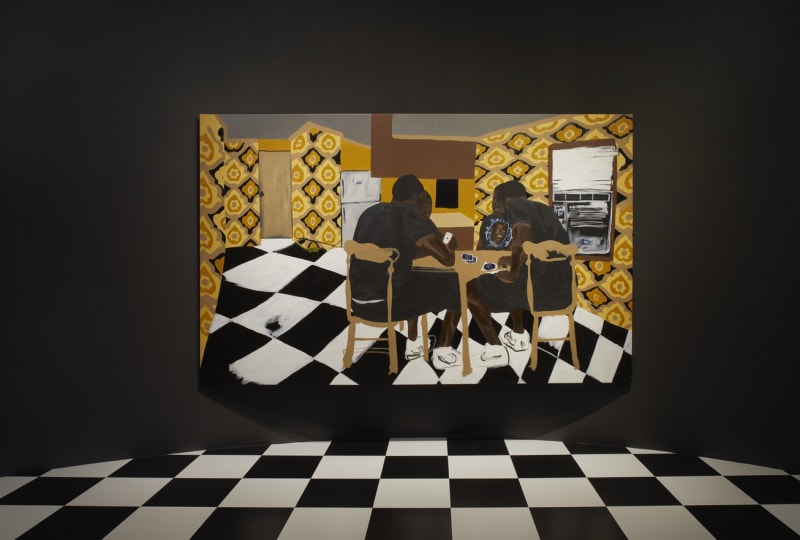Jammie Holmes Pours His Emotions Into His Paintings: ‘When People Look at My Work I Want Them to Feel Something’
BY VICTORIA L. VALENTINE
FOUR YEARS AGO, Jammie Holmes started painting. He was working in a machine shop in Dallas, Texas, and thought the creative outlet would help calm his high blood pressure and anxiety. Between the unprecedented circumstances of the pandemic and quarantine and the urgency of the racial justice protests, the past seven months would raise anyone’s blood pressure and anxiety, but the challenges of 2020 have fueled his practice.
Two paintings by Holmes anchor “To Be Determined,” a new collection exhibition at the Dallas Museum of Art (DMA). A few months ago, he produced a multi-city public art project.
In response to the police killing of George Floyd in Minneapolis, Holmes turned the skies over five cities into his canvas. On May 30, planes flew banners emblazoned with Floyd’s last words over Detroit (“Please I Can’t Breathe”), Dallas (“My Neck Hurts”), Miami (“My Stomach Hurts”), Los Angeles (“Everything Hurts”), and New York (“They’re Going To Kill Me”).
Titled “Jammie Holmes: THEY’RE GOING TO KILL ME,” the public art project is documented in an online exhibition at Dallas Contemporary. The artist calls the action a “public demonstration” designed to connect the cities, and the country, as protestors took to the streets across the nation with a unified message and purpose.
“Enough is enough,” Holmes said in a video explaining the project. “When somebody passes away, you let doves go. Like rest in peace and they fly away to the sky. So it was like it was a good time to give him (Floyd) a moment of silence, from the sky.”
Holmes added: “Either you’re going to be racist and spend your whole life being racist and prejudice or you’re going to have this group of people that’s just all about unity. There’s no middle. It’s no middle. Either you’re about unity or you want to see things go in flames, just for flames sake.”
AT THE DALLAS MUSEUM OF ART, Assistant Curator of Contemporary Art Vivian Crockett commissioned “Four Brown Chairs” (2020) and “Tired” (2020) specifically for “To Be Determined.” Both of the large-scale paintings explore the complexity of Black masculinity and draw on the artist’s childhood memories of family and growing up poor in Thibodaux, La.
In a video conversation with the curator, Holmes sheds light on his practice and the themes evoked in his work. He explained the energy and emotion he pours into each painting. “Sometimes it’s almost draining,” he said. “When people look at my work I want them to feel something.” If a collector doesn’t feel anything when they look at his work, Holmes said he would buy it back.
His work emphasizes that Black men have feelings. “We get tired. We cry. We like floral t-shirts,” he said, none of which takes away from their masculinity. He also suggested police might de-escalate encounters with Black men during traffic stops if they understood them as emotional beings just like everyone else and showed some empathy toward them.
“It could probably help if the cops stop pulling us over and thinking automatically there’s an argument about to happen,” Holmes said. “This guy, he could just be having a bod day. Ask him what’s wrong. Everything’s okay at home? I’m not trying to be in your business or anything. I noticed you were speeding. Everything’s okay? You need me to help you get there?”
A series focused on “Child Soldiers” references American youth and the crisis in Sierra Leone, where the artist’s father is from. “I like to speak for child soldiers of American ghettos and the child soldiers abroad. Those kids. I am deeply rooted in Sierra Leone,” Holmes said. “That’s my family.”
He grew up in a women-centered household, and his mother, aunts, and grandmother appear in his work. The black-and-white checkerboard floor that recurs in some of his paintings grounds the work in the interior spaces he grew up with in the South and also symbolizes the ying and yang of his personality and the good and bad sides of life.
The artist and curator talked about the two paintings on view at the museum. Both are color-rich domestic scenes with strong narratives. Crockett said she wanted to discuss “Four Brown Chairs,” which DMA acquired.
“The presence, it’s four Black men taking up space at the Dallas Museum of Art,” she said. “Like, that is no small thing. That is really meaningful for me and I know it’s really meaningful for you. I would like to know more about the process behind this work. Why you painted what you did.”
Holmes agreed the opportunity to show the works was important to him. “I wanted to give the DMA something that I haven’t seen before. I haven’t seen in Dallas before. I wanted to show who I am as a person on a large scale and I wanted to show the pain, the hurt, the worn look on their faces. See, one of the guys sitting at the table has a Rest in Peace t-shirt on. It’s for my cousin that passed away,” the artist said in the video.
“I wanted to show that pain. I wanted to show that mystery of wondering, like, because you cannot walk past them. Because, to this day, even though I created it, I sit down and I look at it and you cannot help to wonder what they are thinking about. It’s a painting, but I know exactly what I was intentionally doing, because when you look at it, you feel that emotion.”
Homes added: “It’s like dang. I don’t know what’s going on, but I need to know what they are talking about. How they feel. Are they okay? Everything. I wanted those questions to be asked about these men.”


